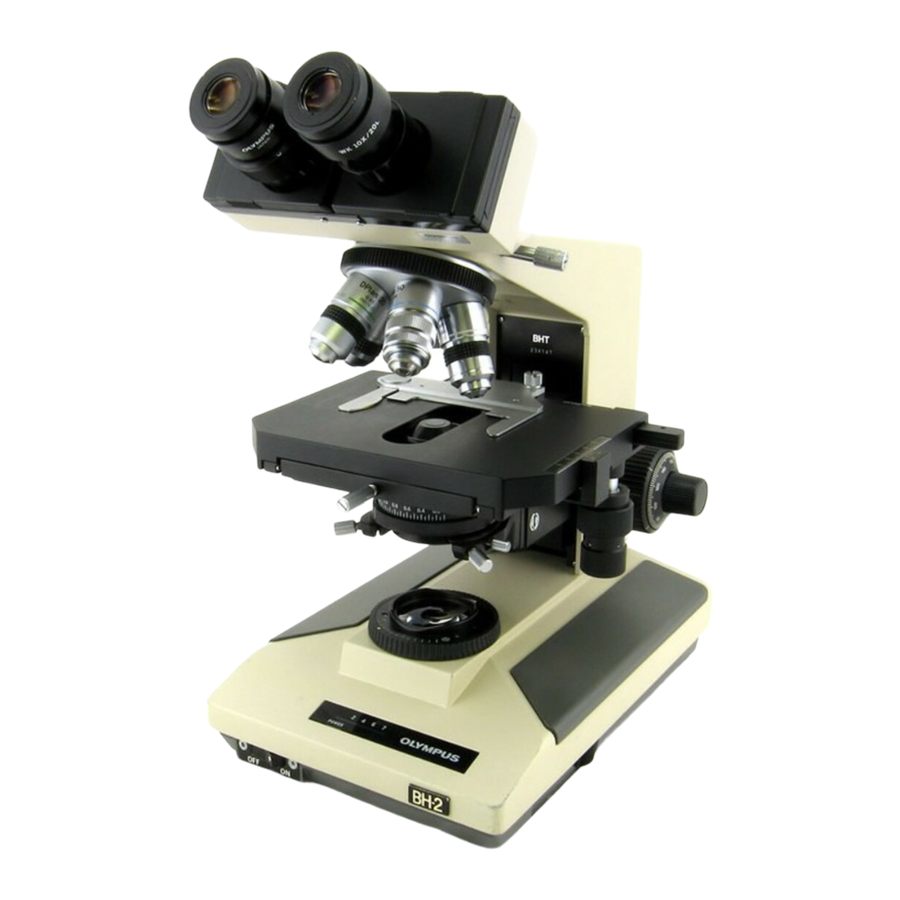Olympus BH2 Series Manual - Página 6
Navegue en línea o descargue pdf Manual para Microscopio Olympus BH2 Series. Olympus BH2 Series 6 páginas. Phase contrast
También para Olympus BH2 Series: Manual de solución de problemas y ajuste (46 páginas), Desmontaje, limpieza y montaje completos (23 páginas), Desmontaje, limpieza y montaje completos (40 páginas), Desmontaje, limpieza y montaje (45 páginas), Manual de instalación (9 páginas)

Figure 9 – Place green/yellow filter into filter receptacle
Congratulations, you have now properly setup your
BH-2 microscope for phase contrast viewing.
Using Phase Contrast
The hard part is now done. From here on out, to use
phase contrast, just be sure to always match the
number on the selector dial on the front of the phase
contrast condenser with the magnification of the
selected phase contrast objective. That is basically all
there is to it. Don't forget to return the selector dial on
the phase contrast condenser to the "0" setting
whenever you wish to switch back to regular brightfield
viewing.
Periodically Verify Centering of the Phase Annuli
It is good practice to re-check the centering of the
phase annuli before starting a phase contrast
observation session. With practice, you will come to
see that once the phase annuli have been centered,
they rarely need to be re-adjusted.
About the Phase Contrast Filter
Note that it is necessary to use the green/yellow filter in
the illumination system, in order to provide light of the
proper wavelengths with which the phase contrast
objectives were designed to operate. This is critical if
you wish to obtain optimal phase contrast results. This
filter is particularly important when you wish to
perform photomicrography, since that's when image
quality is most critical. The inevitable green/yellow cast
that the filter imparts may be removed from the images
by converting them to grayscale.
For routine viewing, however, you may find that you
prefer to omit the green filter from the illumination
system, knowing that the phase contrast effects will be
less than ideal, but the resulting color rendition will be
much closer to normal.
Phase Contrast on the Olympus BH-2 Microscopes
Phase Contrast Artifacts
Certain visual artifacts will inevitably appear when
viewing specimens under phase contrast, which can
sometimes make it difficult to accurately interpret the
resulting images. The bad news is you really cannot get
rid of these artifacts. You will find that certain
specimens are ideally suited for phase contrast,
whereas others are better suited to regular brightfield
viewing, because of these artifacts.
Halos: The most obvious phase contrast artifacts are the
halos which you will see surrounding your specimens.
These halos are caused by some of the diffracted light
from the specimen passing through the phase ring in
the objective. Ideally, only the background illumination
should pass through the phase ring, and only diffracted
light should pass through the areas inside and outside
the phase ring. In positive phase contrast imaging (i.e.,
when using PL or PLL phase contrast objectives), this
effect causes larger objects have a brighter edge,
whereas in negative phase contrast (i.e., when using
NM or NH phase contrast objectives), this effect causes
them to have a darker edge.
Shade-Off Effect: Another phase contrast artifact is
known as the Shade-Off Effect.
homogeneous parts of the image show up at the same
brightness level as the background (i.e., the same as the
surrounding medium). This occurs because although
the light experiences a phase shift as it passes through
these regions of the specimen, only minimal diffraction
occurs and the angle it scatters is therefore limited,
causing it to pass through the phase ring and therefore
not experience the desired interference.
Contrast Inversion: A third phase contrast artifact is
known as Contrast Inversion. In the case of positive
phase contrast, objects with a high index of refraction
situated next to objects with a low index of refraction
will appear brighter than the background, instead of
darker. This happens because in these cases the phase
shift is not the usual quarter wave that should occur,
and instead of the expected destructive interference
occurring, constructive interference occurs instead. The
opposite of this is true for negative phase contrast.
How To Contact the Author
Please feel free to direct any questions or comments
regarding this document (or BH-2 microscopes in
general) to the author as listed on the cover page of this
document.
Revision 1
In this case, the
Page 6 of 6
